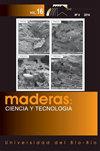用声学测试估计木聚合物复合材料的强度和刚度
IF 1.5
4区 农林科学
Q2 Agricultural and Biological Sciences
引用次数: 0
摘要
本研究采用超声和应力波传播的无损检测方法对木聚合物复合材料的抗弯强度和刚度进行了评价。用不同配方的聚合物基体(高密度聚乙烯、低密度聚乙烯、聚丙烯)、不同种类和比例的面粉(椰壳和木材)生产了12种复合板产品。力学和声学性能主要受复合材料中使用的基体类型的影响。木材和椰子壳粉的比例越大,波的传播速度、刚度和强度越高。我们发现机械性能(强度和刚度)与波速和刚度系数之间存在相关性。我们还提出了试样的刚度和强度作为波速和通过无损检测得到的刚度系数的函数的线性回归方程。对于聚丙烯和高密度聚乙烯基复合材料,刚度系数能较好地估计刚度,而对于低密度聚乙烯基复合材料,波速能较好地估计刚度。本文章由计算机程序翻译,如有差异,请以英文原文为准。
Using acoustic testing to estimate strength and stiffness of wood-polymer composites
This study used non-destructive testing with ultrasonic and stress wave propagation to evaluate bending strength and stiffness of wood-polymer composites. Twelve composite plate products were produced with different formulations of polymer matrix (high- and low-density polyethylene and polypropylene) and type and proportion of flour (coconut shell and wood). Mechanical and acoustic properties were influenced primarily by the type of matrix used in the composite. The greater the proportion of wood and coconut shell flour the higher the wave propagation velocity, stiffness, and strength. We found a correlation between mechanical properties (strength and stiffness) and wave velocity and stiffness coefficient. We also present linear regression equations of the stiffness and strength of the specimen as a function of wave velocity and stiffness coefficient obtained through non-destructive testing. For polypropylene and high-density polyethylene matrix composites, the stiffness coefficient provided a better estimate of stiffness, while for low-density polyethylene the wave velocity provided better results.
求助全文
通过发布文献求助,成功后即可免费获取论文全文。
去求助
来源期刊

Maderas-Ciencia Y Tecnologia
MATERIALS SCIENCE, PAPER & WOOD-
CiteScore
2.80
自引率
13.30%
发文量
33
审稿时长
>12 weeks
期刊介绍:
Maderas-Cienc Tecnol publishes inedits and original research articles in Spanish and English. The contributions for their publication should be unpublished and the journal is reserved all the rights of reproduction of the content of the same ones. All the articles are subjected to evaluation to the Publishing Committee or external consultants. At least two reviewers under double blind system. Previous acceptance of the Publishing Committee, summaries of thesis of Magíster and Doctorate are also published, technical opinions, revision of books and reports of congresses, related with the Science and the Technology of the Wood. The journal have not articles processing and submission charges.
 求助内容:
求助内容: 应助结果提醒方式:
应助结果提醒方式:


